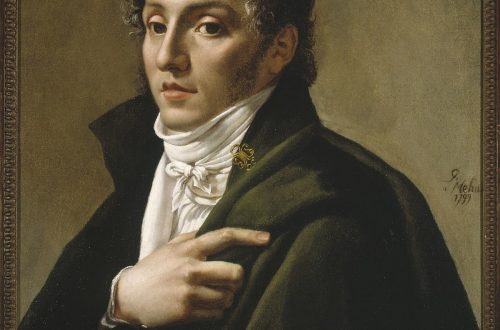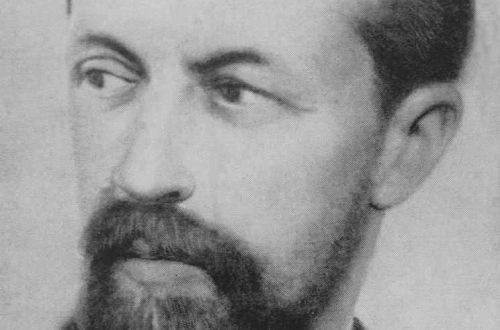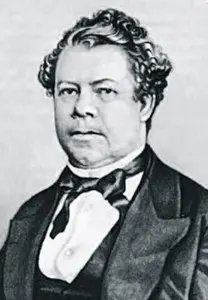
Alexander Varlamov (Alexander Varlamov) |
Alexander Varlamov
Romances and songs by A. Varlamov are a bright page in Russian vocal music. A composer of remarkable melodic talent, he created works of great artistic value, which won rare popularity. Who does not know the melodies of the songs “Red Sundress”, “Along the street a snowstorm sweeps” or the romances “A lonely sail turns white”, “At dawn, do not wake her up”? As a contemporary rightly remarked, his songs “with purely Russian motifs have become popular.” The famous “Red Sarafan” was sung “by all classes – both in the living room of a nobleman and in a peasant’s chicken hut”, and was even captured in a Russian popular print. Varlamov’s music is also reflected in fiction: the composer’s romances, as a characteristic element of everyday life, are introduced into the works of many writers – N. Gogol, I. Turgenev, N. Nekrasov, N. Leskov, I. Bunin and even the English author J. Galsworthy ( novel “The End of the Chapter”). But the fate of the composer was less happy than the fate of his songs.
Varlamov was born into a poor family. His musical talent manifested itself early: he self-taught learned to play the violin – he picked up folk songs by ear. The beautiful, sonorous voice of the boy determined his future fate: at the age of 9 he was admitted to the St. Petersburg Court Singing Chapel as a juvenile chorister. In this illustrious choir group, Varlamov studied under the guidance of the director of the chapel, the outstanding Russian composer D. Bortnyansky. Soon Varlamov became a choir soloist, learned to play the piano, cello, and guitar.
In 1819, the young musician was sent to Holland as a chorister teacher in the Russian embassy church in The Hague. A world of new diverse impressions opens up before the young man: he often attends opera and concerts. he even performs publicly as a singer and guitarist. Then, by his own admission, he “deliberately studied the theory of music.” Upon his return to his homeland (1823), Varlamov taught at the St. Petersburg Theater School, studied with the singers of the Preobrazhensky and Semenovsky regiments, then again entered the Singing Chapel as a chorister and teacher. Soon, in the hall of the Philharmonic Society, he gives his first concert in Russia, where he conducts symphonic and choral works and performs as a singer. Meetings with M. Glinka played a significant role – they contributed to the formation of independent views of the young musician on the development of Russian art.
In 1832, Varlamov was invited as an assistant to the conductor of the Moscow Imperial Theatres, then received the position of “composer of music.” He quickly entered the circle of the Moscow artistic intelligentsia, among which there were many talented people, versatile and brightly gifted: actors M. Shchepkin, P. Mochalov; composers A. Gurilev, A. Verstovsky; poet N. Tsyganov; writers M. Zagoskin, N. Polevoy; singer A. Bantyshev and others. They were brought together by an ardent passion for music, poetry, and folk art.
“Music needs a soul,” wrote Varlamov, “and the Russian has it, the proof is our folk songs.” During these years, Varlamov composes “The Red Sundress”, “Oh, it hurts, but it hurts”, “What kind of heart is this”, “Do not make noise, violent winds”, “What has become foggy, the dawn is clear” and other romances and songs included in “ Musical album for 1833″ and glorified the name of the composer. While working in the theatre, Varlamov writes music for many dramatic productions (“Two-wife” and “Roslavlev” by A. Shakhovsky – the second based on the novel by M. Zagoskin; “Prince Silver” based on the story “Attacks” by A. Bestuzhev-Marlinsky; “Esmeralda” based on the novel “Notre Dame Cathedral” by V. Hugo, “Hamlet” by V. Shakespeare). The staging of Shakespeare’s tragedy was an outstanding event. V. Belinsky, who attended this performance 7 times, enthusiastically wrote about Polevoy’s translation, Mochalov’s performance as Hamlet, about the song of the insane Ophelia…
Ballet also interested Varlamov. 2 of his works in this genre – “Fun of the Sultan, or the Seller of Slaves” and “The Cunning Boy and the Ogre”, written together with A. Guryanov based on the fairy tale by Ch. Perrault “The Boy-with-a-finger”, were on the stage of the Bolshoi Theater. The composer also wanted to write an opera – he was fascinated by the plot of A. Mickiewicz’s poem “Konrad Wallenrod”, but the idea remained unrealized.
Varlamov’s performing activity did not stop throughout his life. He systematically performed in concerts, most often as a singer. The composer had a small, but beautiful tenor in timbre, his singing was distinguished by rare musicality and sincerity. “He inimitably expressed … his romances,” one of his friends remarked.
Varlamov was also widely known as a vocal teacher. His “School of Singing” (1840) – the first major work in Russia in this area – has not lost its significance even now.
The last 3 years Varlamov spent in St. Petersburg, where he hoped to again become a teacher in the Singing Chapel. This wish did not come true, life was difficult. The wide popularity of the musician did not protect him from poverty and disappointment. He died of tuberculosis at the age of 47.
The main, most valuable part of Varlamov’s creative heritage are romances and songs (about 200, including ensembles). The circle of poets is very wide: A. Pushkin, M. Lermontov, V. Zhukovsky, A. Delvig, A. Polezhaev, A. Timofeev, N. Tsyganov. Varlamov opens for Russian music A. Koltsov, A. Pleshcheev, A. Fet, M. Mikhailov. Like A. Dargomyzhsky, he is one of the first to address Lermontov; his attention is also attracted by translations from I. V. Goethe, G. Heine, P. Beranger.
Varlamov is a lyricist, a singer of simple human feelings, his art reflected the thoughts and aspirations of his contemporaries, was in tune with the spiritual atmosphere of the era of the 1830s. “Thirst for a storm” in the romance “A lonely sail turns white” or the state of tragic doom in the romance “It’s hard, there is no strength” are images-moods characteristic of Varlamov. The trends of the time affected both the romantic aspiration and the emotional openness of Varlamov’s lyrics. Its range is quite wide: from light, watercolor paints in the landscape romance “I love to look at a clear night” to the dramatic elegy “You are gone”.
Varlamov’s work is inextricably linked with the traditions of everyday music, with folk songs. Deeply grounded, it subtly reflects its musical features – in language, in subject matter, in figurative structure. Many images of Varlamov’s romances, as well as a number of musical techniques associated primarily with melody, are directed to the future, and the composer’s ability to raise everyday music to the level of truly professional art deserves attention even today.
N. Sheets





